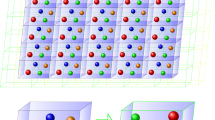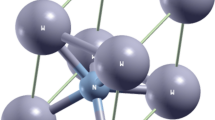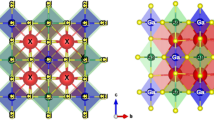Abstract
The results of the study of the temperature dependence of attenuation and velocity of ultrasonic waves are presented for CaF2:Cr and CaF2:Ni crystals in which Cr2+ and Ni2+ ions substitute calcium ions, forming Jahn–Teller (JT) complexes [CrF8]6– and [NiF8]6–. The Cr2+ and Ni2+ ions in the fluorite structure have threefold orbital degeneracy in the ground state, are described by the T \( \otimes \) (e + t2) Jahn–Teller effect (JTE) problem, and have an adiabatic potential energy surface (APES) defined in the five-dimensional space of trigonal and tetragonal symmetrized coordinates whose lower sheet is a simply connected surface with orthorhombic minima separated by potential energy barriers. The temperature dependence of the ultrasonic attenuation and velocity exhibits anomalies typical of the relaxation contributions of systems of JT complexes in the low-temperature region. The effect of tunneling relaxation mechanisms (direct and two-phonon transitions) on the JT contribution to the complex elastic moduli and to the error in determining the relaxation time is analyzed. Based on the approach that takes into account both tunneling and activation mechanisms of relaxation, the activation energies and the constants characterizing these relaxation mechanisms are determined in CaF2:Cr2+ and CaF2:Ni2+ crystals.










Similar content being viewed by others
REFERENCES
H. A. Jahn and E. Teller, Proc. R. Soc. London, Ser. A 161, 220 (1937).
I. B. Bersuker, The Jahn–Teller Effect (Cambridge Univ. Press, Cambridge, 2006).
I. B. Bersuker, J. Phys.: Conf. Ser. 833, 012001 (2017).
M. Acosta, N. Novak, V. Rojas, S. Patel, R. Vaish, et al., Appl. Phys. Rev. 4, 041305 (2017).
M. D. Kaplan and G. O. Zimmerman, J. Phys.: Conf. Ser. 833, 012007 (2017).
D. Liu, N. Iwahara, and L. F. Chibotaru, Phys. Rev. B 97, 115412 (2019).
J. L. Dunn and E. Rashed, J. Phys.: Conf. Ser. 1148, 012003 (2018).
Yu. S. Orlov, S. V. Nikolaev, S. G. Ovchinnikov, and A. I. Nesterov, JETP Lett. 112, 250 (2020).
S. Merten, O. Shapoval, B. Damaschke, et al., Sci. Rep. 9, 2387 (2019).
V. Polinger and I. B. Bersuker, J. Phys.: Conf. Ser. 833, 012012 (2017).
M. Angeli, E. Tosatti, and M. Fabrizio, Phys. Rev. X 9, 041010 (2019).
A. V. Kuzmin, S. S. Khasanov, K. P. Meletov, and R. P. Shibaeva, J. Exp. Theor. Phys. 128, 878 (2019).
K. M. Krasikov, A. N. Azarevich, V. V. Glushkov, S. V. Demishev, A. L. Khoroshilov, A. V. Bogach, N. Yu. Shitsevalova, V. B. Filippov, and N. E. Sluchanko, JETP Lett. 112, 413 (2020).
M. D. Sturge, Solid State Phys. 20, 91 (1968).
W. Ulrici, Phys. Status Solidi 84, K155 (1977).
M. M. Zaripov, V. F. Tarasov, V. A. Ulanov et al., Phys. Solid State 37, 437 (1995).
P. B. Oliete, V. M. Orera, and P. J. Alonso, Phys. Rev. B 53, 3047 (1996).
P. B. Oliete, V. M. Orera, and P. J. Alonso, Phys. Rev. B 54, 12099 (1996).
S. K. Hoffmann, J. Goslar, S. Lijewski, and V. A. Ulanov, J. Chem. Phys. 127, 124705 (2007).
C. Zener, Elasticity and Anelesticity of Metals (Univ. Chicago Press, Chicago, 1948).
V. V. Gudkov, M. N. Sarychev, S. Zherlitsyn, et al., Sci. Rep. 10, 7076 (2020).
N. S. Averkiev, I. B. Bersuker, V. V. Gudkov, I. V. Zhevstovskikh, M. N. Sarychev, S. Zherllitsyn, S. Yasin, G. S. Shakurov, V. A. Ulanov, and V. T. Surikov, in Fluorite: Structure, Chemistry and Applications, Ed. by M. van Asten (Nova Science, New York, 2019), Chap. 2, p. 111.
N. S. Averkiev, I. B. Bersuker, V. V. Gudkov, I. V. Zhevstovskikh, M. N. Sarychev, S. Zherlitsyn, S. Yasin, Yu. V. Korostelin, and V. T. Surikov, J. Exp. Theor. Phys. 129, 72 (2019).
Y. P. Varshni, Phys. Rev. B 2, 3952 (1970).
M. N. Sarychev, W. A. L. Hosseny, A. S. Bondarevskaya, et al., J. Alloys Compd. 848, 156167 (2020).
M. N. Sarychev, A. S. Bondarevskaya, I. V. Zhevstovskikh, V. A. Ulanov, G. S. Shakurov, A. V. Egranov, V. T. Surikov, N. S. Averkiev, and V. V. Gudkov, JETP Lett. 113, 47 (2021).
V. V. Gudkov, in The Jahn–Teller Effect: Fundamentals and Implications for Physics and Chemistry, Ed. by H. Koppel, D. R. Yarkony, and H. Barentzen (Springer, Berlin, 2009), p. 743.
M. M. Zaripov, V. S. Kropotov, L. D. Livanova, and V. G. Stepanov, Sov. Phys. Solid State 9, 155 (1967).
M. M. Zaripov, V. F. Tarasov, V. A. Ulanov, and G. S. Shakurov, Phys. Solid State 44, 2050 (2002).
I. V. Zhevstovskikh, I. B. Bersuker, V. V. Gudkov, et al., J. Appl. Phys. 119, 225108 (2016).
Funding
At the Ural Federal University, the research was supported by the Russian Foundation for Basic Research (project no. 18-02-00332a), by the Center of Excellence of the Ural Federal University “Radiation and Nuclear Technologies,” and by the Ministry of Science and Higher Education of the Russian Federation within the State Assignment no. FEUZ-2020-0060. At the South Ural State University, the research was supported by the Government of the Russian Federation (Act 211, contract no. 02.A03.21.0011, Program 5-100). The research at the Mikheev Institute of Metal Physics, Ural Branch, Russian Academy of Sciences, was carried out within the State Assignment no. AAAA-A18-118020190098-5. The research at the Zavoisky Physical–Technical Institute, Federal Research Center Kazan Scientific Center, Russian Academy of Sciences, was carried out within the State Assignment no. АААА-А18-118030690040-8.
Author information
Authors and Affiliations
Corresponding author
Additional information
Translated by I. Nikitin
Rights and permissions
About this article
Cite this article
Sarychev, M.N., Bondarevskaya, A.S., Zhevstovskikh, I.V. et al. Relaxation Contribution of a System of Jahn–Teller Complexes to the Elastic Moduli of Doped Fluorites. J. Exp. Theor. Phys. 132, 790–799 (2021). https://doi.org/10.1134/S106377612105006X
Received:
Revised:
Accepted:
Published:
Issue Date:
DOI: https://doi.org/10.1134/S106377612105006X




